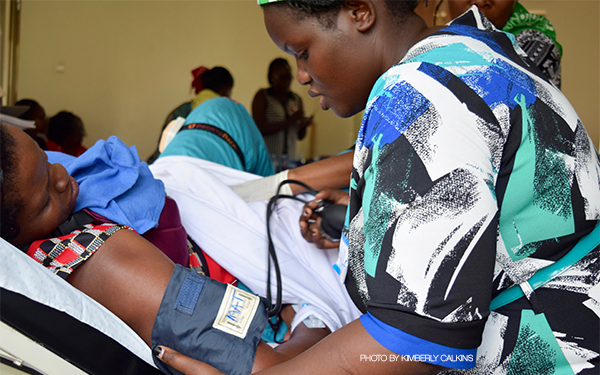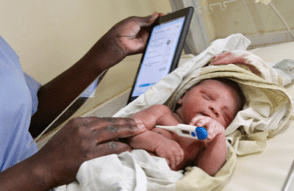
Nicole Santos, PhD, MS, manager of the UCSF East Africa Preterm Birth Initiative’s Discovery Research aim, says the program “builds capacity,” but that phrase is too modest. Truth is that PTBi-EA – and Discovery Research, in particular – is sparking a movement in Kenya, Rwanda and Uganda aimed at defeating the stubborn global epidemic of preterm birth, the largest killer of children under five.
Consider Ugandan physician and researcher Mary Kakuru Muhindo, MBChB. Her Discovery Research-backed pilot study has given her a new and fruitful research direction, connected her with a global community of preterm birth researchers – and spawned care improvements at one hospital, which she expects to see spread to many other low-resource health care settings.
Testing Tools to Improve Treatment of Preterm Neonates
Muhindo’s research career began with the Infectious Diseases Research Collaboration (IDRC), a joint effort of Makerere University in Uganda and UCSF. There, she found two mentors: Ugandan physician and researcher Moses Kamya, MBChB, MMed, PhD, MPH, and UCSF pediatric infectious disease specialist Theodore Ruel, MD, who co-founded Global Strategies, a nonprofit dedicated to using healthcare to improve the lives of women and children in neglected regions of the world. When the Discovery Research Program issued its first request for proposals, Ruel encouraged her to apply.
“Mary cares about pediatric care at [Tororo District Hospital] and was already doing what she could to improve that care outside of research, including passing the hat to raise money for supplies,” says Ruel. “This was a chance to really establish herself as an independent investigator.”

Muhindo’s initial proposal identified the challenges nurse-midwives face in delivering high quality care to preterm infants. Working with Ruel and pediatrician Joshua Bress, MD, current president of Global Strategies, she crafted what would be her first qualitative research study around that challenge: testing the feasibility and acceptability of Ugandan nurse-midwives using the Global Strategies-developed NoviGuide, a mobile health technology for the management of neonatal care. According to the Global Strategies website, NoviGuide “helps clinicians accurately dose medications, intravenous fluids and nasogastric feedings so that sick babies can get immediate and precise care, avoid transport to escalation sites, and survive conditions that are often deadly.”
Muhindo worked closely with the Ministry of Health to align NoviGuide with Ugandan guidelines, and brought the nurse-midwives aboard, helping to teach them how the tool works. “Whenever you study software, you are really studying the people who use it,” says Bress. “Dr. Muhindo’s research taught us about midwives.”
The result was that during the yearlong study, nurse-midwives made 1,600 entries in the tool and, says Muhindo, “They reported that NoviGuide saved them time and prevented mistakes – and that they would recommend it to colleagues working in other hospitals.” The findings point the way to future and more expansive studies.
Moreover, says Muhindo, the study helped inspire Tororo Hospital to hire more midwives and create a neonatal ward, with a focus on skin-to-skin contact between mother and child. She, Ruel and Bress are currently at work on the first manuscript from the study, and Muhindo presented the results at a 2017 UNICEF event in New York City. She is also a 2019 PTBi post-doctoral fellow, a joint program between PTBi-EA and PTBi-California. She is planning to use her time to explore how new functionalities in NoviGuide – Muhindo calls it “a wonder tool” – can further improve newborn care and reduce neonatal mortality in resource-limited, rural settings. “She is the path to broader use in settings that very much need this tool,” says Bress.
A Holistically Growing Community of Researchers
As impressive as her project is, Muhindo is just one example of the power of the Discovery Research vision – a vision realized by two complementary arms.
Muhindo entered the program through the first, which funds projects for East African researchers through a competitive request for proposal (RFP) process. Researchers submit an initial short proposal that identifies a gap they want to address. Those who make the cut are often paired with mentors, usually from UCSF, to create a final proposal. Through three completed RFP cycles, the program has received 89 submissions, and awarded 13 pilot projects and two “team science” grants involving 16 principal investigators from 8 institutions – including 14 early career investigators.
The projects – usually transdisciplinary – either focus on prediction and prevention of preterm birth, or on management and care of preterm infants. The team science projects seek to optimize resources by pairing researchers whose research interests are complementary; perhaps they can work with the same patient cohort or the same resources to study different, but related topics. One example from Kenya: as one investigator studies how exposure to indoor pollutants might increase risk for preterm birth, another is working with the same cohort to study the risk of preterm birth from exposure to soil and water toxicants.
“The RFP arm is informed by our recognition that no one understands these issues in East Africa better than them,” says Santos, who also manages the PTBi post-doctoral fellowship program. “It leverages the expertise of both African researchers and UCSF to foster a community of individuals who think about preterm birth every day, in every aspect of their work.” She believes that by creating new opportunities for early career African investigators, the RFP arm is developing a pipeline of next generation researchers ideally suited to leading a movement that can truly drive positive change.
The other arm of Discovery Research involves supporting targeted studies that address priority research areas in the prematurity field. The first round of these studies aims to get a handle on the scope of the problem, since data in East Africa on preterm birth has been hard to come by, including fully defining what is preterm and what is not. In many areas, it is not always clear where mothers are in their pregnancy, so these studies have sought a way to more accurately and scientifically measure gestational age. “The gold standard, early ultrasound, is not available in many of the settings we work, so some investment in finding point-of-care diagnostics is needed,” says Santos.
To that end, Ugandan researcher and physician Jude Mulowooza is exploring the use of ultrasound at labor triage to improve identification of preterm labor. UCSF researcher Susan Fisher is striving to develop placenta-derived biomarkers during pregnancy, and UCSF researcher Laura Jelliffe is validating the use of a metabolic algorithm at birth to confirm gestational age.
Forging Ahead
Santos says the findings emerging from Discovery Research are especially relevant because the people living the challenges are driving the work.
“No one thing causes prematurity and we’re generating a lot of global learning by helping to foster more locally relevant, context-driven research,” she says. “Maybe the biggest thing we’ve learned is that the research communities in these settings are hungry for these types of opportunities and passionate about this work.”
Muhindo intends to use her passion to grow her skill set during her PTBi fellowship. “The fellowship will provide me with new skills in qualitative research and implementation science as we evaluate whether new functionalities in NoviGuide can facilitate the rollout, maintenance and monitoring of oxygen saturation monitoring in the care of neonates in a rural district hospital in Uganda,” she says. “I am grateful that this will help me transition to becoming an independent investigator who can make a significant contribution to transforming newborn health, especially for vulnerable preterm babies in resource limited settings.”
“The fellowship is perfect for Mary, because it gives a very promising researcher fully protected time and formal training she needs to become an academic leader in her country,” says Ruel. “We just had our first planning call and we are all looking forward to next year.”
Santos adds that the connections the program facilitates go beyond the work itself. “It’s been an honor and a privilege to meet and make so many new friends,” she says.